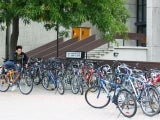
Plant Operations is working to reduce energy use and shrink our environmental footprint on campus.
As a result of these efforts, Waterloo has had one of the lowest energy consumptions per unit area among Ontario universities for the past 20 years.
Our current energy consumption is 1.45 GJ / M2 (06/07). Our energy intensity is about 30 per cent lower than the Ontario system average and almost 40 per cent lower than the average commercial/institutional energy use as reported by Natural Resources Canada.
Our sustainability initiatives include:
- Energy Conservation
- Water Conservation
- Waste Management
- Air Quality
- Environmental Initiatives
- Turf Management
- Transportation
Energy Conservation
Energy Conservation and Demand Management Plans
2019 Energy Conservation and Demand Management Plan (pdf)
2024 Energy Conservation and Demand Management Plan (pdf)
Electrical and Lighting
- Ongoing lighting retrofits use high-efficiency electronic ballasts and lamps, as well as occupancy sensors. Exterior lighting has been converted to high-pressure sodium units.
- High-efficiency lighting is mandated during renovations and for new construction projects.
- Variable flow pumping and fan systems result in lower energy consumption.
District Heating and Cooling
- Economizer installations recover waste heat from boiler exhaust. An extensive heat recovery system has been installed to allow condensing operation of the central boiler plant.
- Air conditioning systems have been replaced with high-efficiency CFC-free machines.
- Using automated systems, procedures are implemented on a continuous basis to reduce electrical and heating loads.
- Boiler system operating pressures have been reduced from 1200 to 860 kpa.
- Improvements to steam line insulation reduce distribution system losses.
Automation of Systems
- Ventilation system schedules are determined by the expected usage of the area, with fans being shut down during periods of minimal occupancy. Night time and weekend temperature adjustments are implemented.
- Building automation systems conserve energy by measuring carbon dioxide, temperature, and humidity to control the amount of outside air required for ventilation.
- Electronic boiler controls adjust oxygen levels to optimize combustion efficiency of major boiler systems.
- Electronic controllers on cooling systems reduce water consumption and control algae and bacteria.
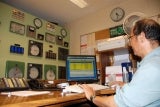
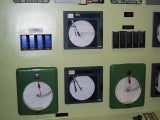
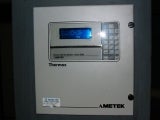
Heating, Ventilation and Air Conditioning (HVAC)
- Free cooling installations minimize the need to operate mechanical refrigeration systems for lab equipment and computer rooms during cool weather.
- Heat-recovery systems have been installed in many buildings and are evaluated for all new construction projects.
- Constant volume ventilation systems in many areas have been retrofitted to variable volume, using variable speed drives to reduce energy consumption.
- Mass thermal storage is used to reduce peak air conditioning loads.
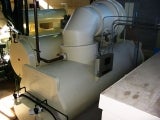
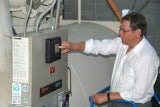
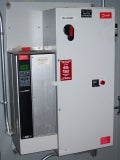
Water Conservation
- Low-flow showers and water-saving plumbing fixtures have been installed throughout the campus.
- Equipment that allowed cooling water to go down the drain has been converted to use closed-loop recirculating systems.
- High-efficiency water softening systems minimize chemical consumption and water use.
Waste Management
- Fine white paper is recycled at white box collection points in all buildings.
- Cans/glass/newsprint/plastic blue box or blue kaddy kart collection is available in all buildings, with office-sized blue boxes being phased in.
- Corrugated cardboard is diverted from landfill.
- Leaves are composted and tree waste and wood products are chipped for mulch.
- Washrooms across campus are stocked with 100-per-cent recycled paper towels and toilet tissue.
- The university currently has a waste diversion rate of 29.2 percent.

Air Quality
The University of Waterloo participates in the Waterloo Region Partners for Clean Air program. The goal is to improve outdoor air quality by reducing harmful emissions. In addition to the measures listed above to reduce overall energy consumption, a smog day policy mandates further emission reductions on days when smog advisories are issued by the Ontario Ministry of the Environment.
Environmental Initiatives
- An environmental reserve has been established on 109 hectares along the North Campus Laurel Creek corridor, providing an outdoor laboratory for research and teaching. The property provides habitat for migratory birds and wildlife — including a Carolinian woodlot — and trails for hikers. The rehabilitation of Columbia Lake is a key part of the project. Preliminary work has been done to encourage a greater diversity of fish species to repopulate the watershed.
- Large and small areas of campus green space have been allowed to naturalize, including the banks of Laurel Creek.
- All new trees and shrubs planted on campus are indigenous species only.



